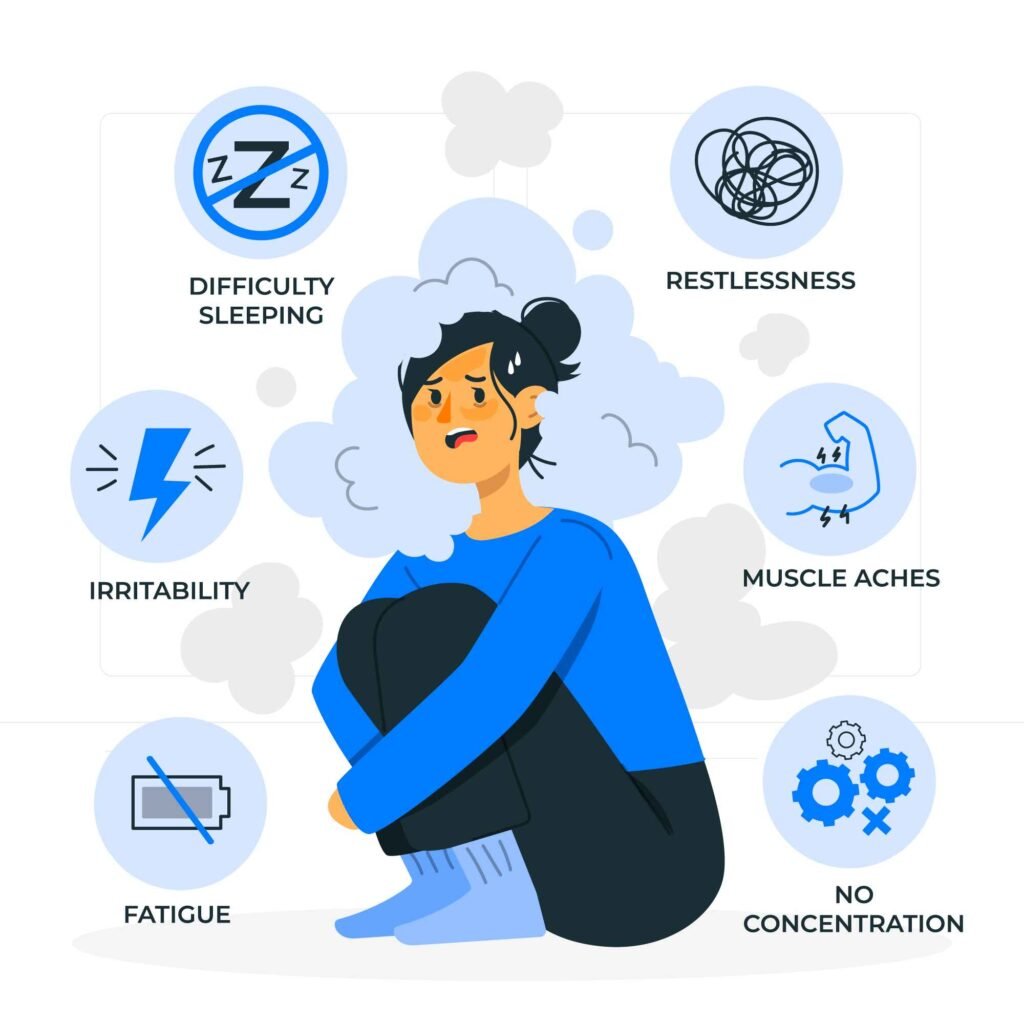
Practical Tips for Managing Seasonal Affective Disorder (SAD): Strategies to Combat Depression and Anxiety During Winter Months
Seasonal Affective Disorder (SAD) is a type of depression that occurs at specific times of the year, often during the fall and winter months when sunlight exposure decreases. SAD can manifest as feelings of sadness, fatigue, anxiety, and difficulty concentrating. This guide will provide actionable strategies to help combat the effects of SAD and improve mental well-being.
Understanding Seasonal Affective Disorder (SAD)
Before diving into practical tips, it’s essential to understand the condition. SAD is more than just the “winter blues.” It is a form of depression linked to changes in light exposure, impacting the body’s internal clock, serotonin levels, and overall mood regulation.
First Half: Understanding the Impact of Light and Lifestyle Adjustments
1. Prioritize Light Exposure
Lack of sunlight is a significant trigger for SAD. To combat this, maximize your exposure to natural light as much as possible. Here’s how:
- Morning Walks: Spend at least 30 minutes outdoors during daylight hours, even if it’s cloudy. Natural light, even in winter, helps regulate your internal clock.
- Light Therapy Lamps: Consider investing in a light therapy lamp that mimics natural sunlight. Use it for 20–30 minutes each morning for a mood boost.
2. Maintain a Consistent Sleep Schedule
SAD often disrupts sleep patterns. To improve rest and mood:
- Regular Bedtimes: Go to bed and wake up at the same time daily, even on weekends.
- Sleep-Friendly Environment: Create a dark, quiet, and comfortable bedroom. Use blackout curtains to eliminate external light and consider a white noise machine for relaxation.
- Avoid Screen Time Before Bed: Reduce exposure to blue light from devices at least an hour before bedtime.
3. Incorporate Physical Activity
Exercise is a powerful tool for combating depression, including SAD. Regular movement releases endorphins, which improve mood and energy levels.
- Outdoor Activities: Take advantage of winter sports like skiing or ice skating.
- Indoor Workouts: On colder days, engage in yoga, dance, or home-based fitness routines.
- Daily Stretching: Simple stretches can reduce muscle tension and promote relaxation.
4. Optimize Your Diet for Better Mental Health
Your food choices can significantly impact your mental well-being. Aim to include:
- Omega-3 Fatty Acids: Found in salmon, walnuts, and flaxseeds, omega-3s improve brain health and mood.
- Vitamin D-Rich Foods: Incorporate fortified milk, egg yolks, and mushrooms into your meals. You might also consider a vitamin D supplement, especially in low-sunlight months.
- Complex Carbohydrates: Whole grains, quinoa, and sweet potatoes can stabilize blood sugar levels and reduce mood swings.
5. Engage in Stress-Reducing Activities
Stress exacerbates the symptoms of SAD. Incorporating calming practices can provide relief:
- Mindfulness Meditation: Spend 10–15 minutes daily practicing mindfulness to focus on the present moment.
- Breathing Exercises: Try techniques like deep diaphragmatic breathing or alternate nostril breathing to calm anxiety.
- Creative Outlets: Engage in hobbies such as painting, writing, or crafting to divert your mind and promote joy.
Managing SAD Through Social Connections and Professional Help
In the second half of the blog post, we’ll delve into the importance of building strong social support, seeking professional guidance, and cultivating a winter-friendly mindset to maintain emotional balance during the colder months.
Second Half: Building Connections and Seeking Professional Support
6. Stay Connected with Friends and Family
Isolation can amplify the effects of Seasonal Affective Disorder. Maintaining social interactions is essential for your mental well-being. Here are a few ways to stay socially engaged:
- Plan Regular Meetups: Schedule coffee dates, walks, or dinner plans with friends and loved ones. Committing to plans can help you stay connected, even when you feel low.
- Join Support Groups: Many communities offer SAD support groups where you can share experiences and coping strategies with people facing similar challenges.
- Virtual Connection: If weather or distance prevents in-person meetings, connect via video calls, online chats, or social media. Virtual interactions can still provide a meaningful sense of community.
7. Participate in Group Activities or Classes
Structured group activities can boost motivation and combat feelings of loneliness:
- Exercise Classes: Join a local gym or online fitness community for yoga, pilates, or dance classes. Group workouts offer accountability and a sense of camaraderie.
- Creative Workshops: Engage in painting, pottery, or writing classes. These activities provide relaxation and an opportunity to learn something new.
- Volunteer Work: Helping others can improve mood and foster a sense of purpose. Consider volunteering at local charities or community centers.
8. Prioritize Emotional Expression
Bottling up emotions can worsen symptoms of SAD. Healthy outlets for expressing emotions can make a significant difference:
- Journaling: Write about your thoughts, feelings, and experiences. Journaling can help you process emotions and identify patterns or triggers.
- Talk it Out: Share your feelings with a trusted friend, partner, or counselor. Verbalizing your struggles can reduce emotional burden.
- Art Therapy: Engage in drawing, painting, or sculpting as a creative way to express complex emotions.
9. Create a Winter Bucket List
Having something to look forward to can help break the monotony of winter. A winter bucket list can provide excitement and motivation:
- Seasonal Activities: Include activities like visiting winter markets, going ice skating, or having a cozy movie night.
- Personal Goals: Set small, achievable goals such as reading a new book, learning a recipe, or organizing your living space.
- Self-Care Plans: Schedule time for relaxing baths, spa days at home, or meditation sessions to nurture your mind and body.
Embracing a Healthy Mindset During Winter
10. Practice Gratitude Daily
Focusing on what you’re thankful for can shift your perspective and improve your mood:
- Gratitude Journal: Write down three things you’re grateful for every day, no matter how small.
- Gratitude Reminders: Create visual reminders, such as sticky notes or affirmations, around your home to keep positivity in focus.
- Share Gratitude: Express appreciation to those around you, which can uplift both you and them.
11. Adopt a Growth Mindset
Viewing challenges as opportunities for growth can help you manage SAD symptoms more effectively:
- Reframe Negative Thoughts: When you catch yourself thinking negatively, consciously reframe the thought into a more positive or neutral perspective.
- Set Realistic Expectations: Understand that it’s okay to have low-energy days. Be kind to yourself and recognize progress, no matter how small.
- Celebrate Achievements: Acknowledge your efforts and celebrate milestones, even if they seem minor. Progress deserves recognition.
12. Use Visualization Techniques
Visualization can promote a sense of calm and optimism:
- Guided Imagery: Picture yourself in a warm, sunny place or visualize achieving a personal goal. Guided meditations can assist with this practice.
- Vision Boards: Create a physical or digital vision board with images and quotes that inspire you. Use it as a reminder of your goals and positive aspirations.
Seeking Professional Help for SAD
13. Consider Therapy Options
If SAD symptoms persist or worsen, professional therapy can provide essential support:
- Cognitive Behavioral Therapy (CBT): CBT helps identify and change negative thought patterns. It’s highly effective for managing SAD and depression.
- Talk Therapy: Discussing your feelings with a licensed therapist can help you process emotions and develop coping strategies.
- Online Therapy: If leaving home feels challenging, explore online therapy platforms for accessible mental health support.
14. Explore Medication Options
In some cases, medication may be necessary to manage SAD symptoms. Consult a healthcare provider to explore options:
- Antidepressants: Selective serotonin reuptake inhibitors (SSRIs) can help balance serotonin levels.
- Supplements: Discuss vitamin D or other supplements with your doctor if deficiencies are contributing to your symptoms.
15. Schedule Regular Check-Ins with a Doctor
Regular visits to a healthcare professional can help monitor your mental health and ensure you receive appropriate care:
- Track Progress: Keep a journal of your mood, sleep patterns, and energy levels to discuss during appointments.
- Adjust Treatment Plans: If current strategies aren’t working, your doctor can suggest alternative approaches or treatments.
- Preventive Care: Regular check-ups can help catch potential health issues early and ensure overall well-being.
Creating a Cozy and Comforting Environment
16. Enhance Your Living Space with Hygge
The Danish concept of “hygge” focuses on creating coziness and warmth during winter. Transform your home into a comforting retreat:
- Soft Lighting: Use candles, fairy lights, or warm-toned lamps to create a soothing atmosphere.
- Warm Textiles: Incorporate soft blankets, pillows, and rugs to make your space more inviting.
- Comfort Rituals: Enjoy a hot cup of tea, read by the fireplace, or listen to calming music.
17. Declutter and Organize Your Space
A clutter-free environment can reduce stress and promote mental clarity:
- Small Steps: Declutter one room or area at a time to avoid feeling overwhelmed.
- Create Zones: Designate spaces for relaxation, work, and hobbies to maintain balance.
- Fresh Scents: Use calming scents like lavender, chamomile, or citrus to enhance your mood.
Third Half: Daily Self-Care Practices and Long-Term Coping Strategies
18. Establish a Morning Routine to Boost Energy
A structured morning routine can set a positive tone for your entire day. Implementing habits that energize you can help combat the lethargy caused by Seasonal Affective Disorder.
- Wake Up at the Same Time: Consistency helps regulate your internal clock and boosts morning alertness.
- Morning Light Exposure: Spend at least 20 minutes in natural sunlight or use a light therapy lamp immediately after waking up.
- Move Your Body: Stretch, do yoga, or take a brisk walk to get your blood flowing and release feel-good endorphins.
- Hydrate and Nourish: Start your day with a glass of water and a nutritious breakfast rich in protein and complex carbs to maintain energy levels.
19. Incorporate Evening Relaxation Rituals
Evenings are a time to unwind and prepare your mind for restful sleep. Developing a calming nighttime routine can improve sleep quality and reduce anxiety.
- Limit Stimulants: Avoid caffeine and alcohol in the late afternoon and evening.
- Unplug from Screens: Power down devices at least an hour before bed to reduce blue light exposure.
- Relaxation Techniques: Try progressive muscle relaxation, a warm bath, or soothing music to calm your mind.
- Bedtime Reading: Choose a light, non-stressful book to help ease you into sleep.
20. Practice Mindfulness and Meditation Daily
Mindfulness and meditation are powerful tools for managing stress, anxiety, and depressive symptoms associated with SAD.
- Daily Meditation Practice: Spend 10–20 minutes in a guided or silent meditation to improve focus and reduce anxiety.
- Body Scan Meditation: Focus on each part of your body, releasing tension as you go. This helps you become more aware of how your body holds stress.
- Mindful Moments: Throughout your day, pause to take deep breaths and ground yourself in the present moment.
21. Use Aromatherapy for Mood Enhancement
Essential oils can positively influence your mood and reduce symptoms of SAD. Some helpful options include:
- Lavender: Promotes relaxation and reduces anxiety.
- Bergamot: Uplifting and known to alleviate stress.
- Peppermint: Energizes and reduces fatigue.
- Citrus Oils: Scents like orange and lemon can boost mood and combat low energy.
Use essential oils in a diffuser, add a few drops to your bath, or apply them with a carrier oil to your wrists and temples.
Nourish Your Mental Health with Positive Habits
22. Challenge Negative Thoughts with Positive Affirmations
Negative thought patterns can become more pronounced during the winter months. Counteracting them with positive affirmations can shift your mindset.
- Daily Affirmation Practice: Start each day with affirmations like, “I am strong and resilient” or “I have control over my emotions.”
- Affirmation Reminders: Place sticky notes with affirmations around your home or workspace for regular encouragement.
- Repeat When Needed: Whenever you feel a wave of negativity, pause and repeat an affirmation to reframe your thinking.
23. Embrace the Outdoors, Regardless of the Weather
Winter’s cold and darkness can make it tempting to stay indoors, but getting outside is vital for mental health.
- Dress Appropriately: Invest in warm, waterproof clothing to stay comfortable during winter walks.
- Find Beauty in Nature: Notice the unique beauty of the winter season, such as frost-covered trees or the quietness of snowy mornings.
- Explore New Trails: Try different parks, nature reserves, or hiking paths to keep outdoor activities exciting.
24. Set Realistic Goals for the Season
Setting achievable goals provides structure and a sense of accomplishment, both of which can boost your mood.
- Break Goals into Steps: Set small, manageable tasks that lead to a larger objective, like decluttering a room or learning a new skill.
- Track Progress: Use a journal or a planner to celebrate milestones and recognize your efforts.
- Adjust as Needed: Be flexible and kind to yourself if goals need adjustment due to unexpected challenges.
Create a Personalized Self-Care Plan
25. Develop a Self-Care Toolkit
A personalized self-care toolkit can serve as your go-to resource during tough days. Include:
- Favorite Relaxation Techniques: Meditation, deep breathing, or a relaxing bath.
- Comfort Items: A cozy blanket, scented candle, or soothing music playlist.
- Mental Health Resources: Books, apps, or helpline numbers you can access when needed.
- Activities You Enjoy: Puzzles, hobbies, or creative outlets that bring you joy.
26. Plan “Me-Time” Regularly
Prioritizing time for yourself is essential for mental well-being. Schedule regular self-care sessions in your calendar.
- Weekly Rituals: Dedicate one night a week to your favorite self-care activity.
- Mini Breaks: Take short breaks throughout the day for relaxation, even if it’s just 10 minutes of stretching or deep breathing.
- Treat Yourself: Enjoy small rewards like a favorite snack, a new book, or a relaxing bath.
Long-Term Strategies for Managing SAD
27. Track Your Symptoms Over Time
Keeping track of your mood, energy levels, and sleep patterns can help you identify triggers and effective coping strategies.
- Mood Journal: Record daily reflections on your mental state, activities, and any interventions you tried.
- Symptom Calendar: Use a calendar to note days when SAD symptoms are worse or better, helping you recognize seasonal patterns.
- Review with Professionals: Share your journal with your therapist or doctor to adjust your treatment plan effectively.
28. Plan for Future Winters
Being proactive can help you better manage SAD each year. Develop a strategy to prepare for the colder months in advance.
- Start Early: Begin light therapy, exercise routines, or mindfulness practices in early fall before symptoms worsen.
- Create a Winter-Ready Home: Stock up on supplies like light therapy lamps, cozy blankets, and comfort foods.
- Maintain Awareness: Reflect on what worked well in previous years and incorporate those strategies again.



